This Post May Contain Affiliate Links
In compliance with the FTC guidelines, please assume that some of the links on these posts and sites are affiliate links (Amazon or others) from which I may earn a small compensation/commission from sales of certain items at no extra cost to you from qualifying purchases.
Anytime you see a link that looks like “astore.com, paid link, #ad, #CommissionsEarned or Amazon/Amazon.com/ca,”… it can be assumed that it is an affiliate link.
To learn more, follow the link below.
A Look At A 6 String vs 7 String Guitar
The First Electric 6-string guitar
Rickenbacker Electrol A-22 “Frying Pan”
Developed in 1931/32 by George Beauchamp, a first-of-its-kind 6-string Electric Lap steel guitar was made from aluminum with acoustic properties.
It had a pickup that incorporated a pair of horseshoe magnets arched over the strings of his steel guitar. It produced an electrical signal that could be amplified over a loudspeaker and was nicknamed ‘Frying Pan” because of its long neck design.
Acoustic Properties & Amplification
With the initial steel guitar design producing uncontrolled and unwanted feedback (Sympathetic Vibration), Beauchamp realized that having an electric instrument with acoustics in the design would not work well together.
With the help of manufacturer Adolph Rickenbacker, Beauchamp designed a lap steel guitar with a solid aluminum body and neck, and the first-ever solid body Electric 6-string guitar patent was created, producing instruments from 1932 to 1939.
The circular body was awarded a patent in 1937, with other guitar companies to follow.
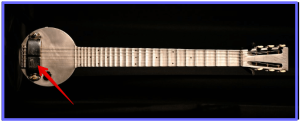
The Ro-Pat-In Cast Aluminum Electric Hawaiian “Frying Pan” Guitar. w/a pair of horseshoe magnets Arched over the strings-The body measures 6 ¼” across the face -Image courtesy of Wikipedia and is licensed under CC BY 3.0
First Commercial 6 String Solid Body Guitar
The Fender Telecaster was the first 6-string solid body (non-lap steel) sold commercially and became the standard for electric Guitar builds. (See Image)
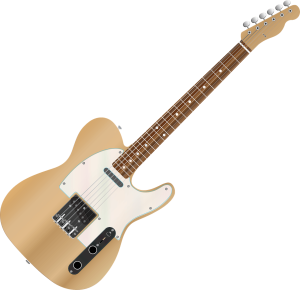
It started its iconic run in 1950, with the Gibson Les Paul released in 1951 and the Fender Stratocaster in 1954.
New Sounds
These new Solid Body guitars dominated the market during the 1960s/ 70s.
Playing a solid body 6-string Guitar through an amp while using effects went on to develop a new music culture of the era.
The Guitar became a lead instrument, not only playing chords but also driving riffs and guitar solos, creating iconic new guitar gods like…
- Jimi Hendrix
- Jeff Beck
- Jimi Page and many more.
The 6-string solid body electric guitar was here to stay and has been at the forefront of virtually every music genre to the present day.
The 7 -string
The modern 7-string Guitar adds an additional string to the more common 6-string versions, with a wider fretboard to accommodate the additional add-on.
History
Influenced by the harp, the history of the 7-string Guitar stretches back more than 230 years during the Renaissance period. ( 1400–1600)
Composer Friendly
Composers of the era produced significant music works and found the added string provided new sonic possibilities.
French guitarist Napoleon Coste (1805–1883) & Italian Guitarist Mario Maccaferri (1899–1993.) composed works specifically with the 7-string Guitar in mind.
In Russia, the 7-string acoustic Russian or Gypsy Guitar became widely popular because of its flexibility, simplicity & sound, which is still popular today.
7 String Electric Designs
First Hollow-body Signature
US Manufactures Epiphone and Gretsch built a Hollow Body Electric 7-string for jazz guitarist George Van Eps.
The signature instrument is reportedly the first 7-string electric Jazz hollow-body archtop guitar produced.
Many jazz musicians tune in a dropped A tuning (A1–E2–A2–D3–G3–B3–E4) for improved bass lines and easier chording.
But as Beauchamp found earlier, most of these guitar designs at high volumes were prone to feedback, making it a problematic instrument for rock guitar players.
First Solid Body 7 String
The first solid-body 7-string electric Guitar was conceived by guitarist Lenny Breau and built by luthier Kirk Sand, debuting in 1983.
It featured a high A-string (instead of an added bass string) usually tuned (E2–A2–D3–G3–B3–E4–A4), opening up the artists’ musical possibilities on the instrument. (See Image)
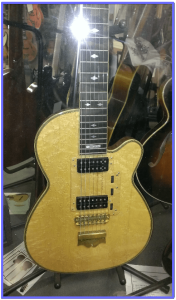
The Lenny Breau custom-built solid body 7-String Guitar w/high “A” string-Image courtesy of Wikipedia and licensed under CC BY-SA 2.0
Breau would use this Guitar to approach his playing like a piano (Both hands on the neck), along with a non-traditional fingerstyle technique to blend different styles of music.
High A String Issues
With the added high A string prone to breaking, Breau & Sand would solve the problem by shortening the Guitar’s standard scale length to 22.75” (577 mm) for the longer the scale length, the higher the tension.
What Is Scale Length?
Scale length refers to the distance between the saddle and the nut.
The standard on a 6-string electric guitar is between 24” (610 mm) to 25.5” (648mm) and 25.5 to 27′ (685mm) for most 7-string models. (More on this later)
First 7-string Signature Rock Guitar
Ibanez & Steve Vai
Drawn to the idea much for the same reasons as the previous Jazz players George Van Eps or Lenny Breau, Vai requested a lower string be added to his new 7-string prototype Guitar, saying…
“It would be cool to have a 7th string.”

Steve Vai in 2006 – Image courtesy of Wikimedia & Released into the public domain.
Vai was already working with the company releasing its mega-popular JEM 777 earlier (1987) and wanted to make a version of the JEM in a 7-string model.
With a tuning of (B1–E2–A2–D3–G3–B3–E4), Vai sought to sonically preserve the full upper range of a standard Guitar for solos but with the added string to generate a heavier sound.
This Joint Venture resulted in the first mass-produced 7 String UV7oP Signature Rock Guitar model. (See Image)

The Ibanez JEM “Universe” UV 70P in Cosmo black w/25-5″ scale, DiMarzio Blaze Pickups & more – Image courtesy of ibanez.com
First Recordings
After splitting from a 2 1/2-year commitment from David Lee Roth, Vai was looking to rest and do a solo project but was asked to support the Whitesnake camp.
Agreeing and with his new prototype, he used the Guitar on the new Whitesnake SLIP OF THE TONGUE album recording and tour (1989), making it the first Heavy Metal Record with a 7-string on the entirety of the recording, saying…
“I loved the record….”
With the new-found versatility and flexibility experienced, he then used the Guitar for his 1990 solo release, Passion and Warfare.
Video
Other Players Onboard
Following suit was John Petrucci (Dream Theater) and the band KoRn, who featured the 7-string Ibanez on their debut album in 1994.
Signature Sound
The 7-string Guitar contributed to giving the band KoRn its “signature sound” before anyone else.
Compositions with low-pitched heavy riffs made the band arguably the first musical act to fully realize the instrument’s sonic potential, creating a whole new movement in music. They quickly became associated with “Nu Metal.”

James “Munky” Shaffer “KoRn” playing a 7 String JEM 7V7 Live @ Rock im the Park 2016 – Image courtesy of Wikipedia & is licensed under the CC BY-SA 3.0
What Is Nu Metal?
This version of Metal is influenced by several musical styles, combining Alternative, Grunge, Funk, Industrial and Heavy Metal.
Riffing
Different in that this style of Metal seldom features guitar solos, Nu Metal is based on heavy guitar riffs and syncopation, with the artist sometime down-tuning the 7 string to “A” to produce an even heavier sound.
Ironically, in their early days, Munky & Head (KoRn Guitarists) were told that the instrument was for more technical/virtuosic players and could not be used for heavy riffing.
New Subculture
Nu Metal would later create a new subculture of 7 String players and music, with manufacturers Jackson, Schecter, and ESP creating models in 2012.
Even though the initial Vai Model was discontinued “temporarily” in 1995, Vai and Ibanez created a newer JEM 7V7 (7 String) model that is identical to the JEM 7VP (6-String) introduced in 2013.
(See Image)
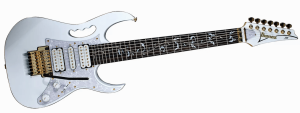
The Ibanez JEM7V7 Steve Vai Signature 7-String Universe (White)-Image courtesy of reverb.com
Advantages Of 7 Over 6-String Guitars
Extra Range & Versatility
Standard Tuning on a 7-string offers all the same options as a 6-string but with an extended range of the added low “B” string.
The tuning would be as follows:

An ESP LTD SH-7 Evertune Signature Series Brian “Head” Welch Electric Guitar with standard 7-string tuning -Image courtesy of Amazon. Tap Image to see more.
5 Extra Notes
With the 5th fret being the same as the low E string on a 6-string guitar, you have 5 extra notes. (see image)
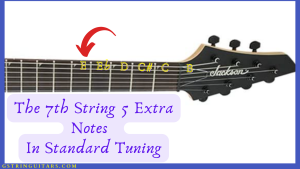
A JS Series Dinky Arch Top JS22-7 HT w 5 extra notes available in Standard “B” tunings-image courtesy of Amazon
7 Extra Notes With (Drop A Tuning)
If you tune the low “B” string down to an “A,” you will gain 7 notes. That looks something like this…
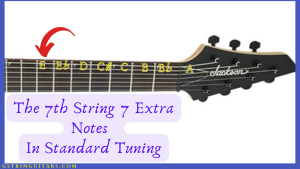
A JS Series Dinky Arch Top JS22-7 HT w 7 extra notes available in Standard “A” tunings-image courtesy of Amazon- Tap Image to see more.
Adding the 5 or 7 notes gives the player the advantage of a more extended range and other sonic versatility without removing the standard options available on a 6-string.
Other advantages include…
Arpeggios & Sweepicking
Arpeggios shapes are easier to play in drop tunings.
They can be executed without moving finger positions on the Fretboard, preventing the changing finger placement generally associated with 6-string arpeggios, making it easier to do techniques like Sweepicking.
Chords
Chords get a powerful, fuller, deeper low end, using both Drop B or Drop A tunings, creating depth and a robust sonic tone.
More Expression
Metal guitarists frequently prefer 7-stringed guitars for their increased scale length, wide necks, range, low-end clarity, tuning stability, specific technique execution, and more expression while playing.
Disadvantages Of A 7 Over 6-String Guitar
Different Feeling Guitar
The Feel of a 7-string vs a 6-string is different based on its wider Fretboard.
While the strings and notes are the same on those upper six strings, it won’t feel like you’re playing a regular guitar.
It can be more challenging to master.
The most obvious example is when you’re used to strumming chords or “Palm Muting,” you must slightly adjust your techniques to accommodate for the low-added string,
Scale Length
The 7-string scale length is generally longer and makes for wider fret spacing.
It may be awkward to have the fingers of your fretting hand reach over the wider Fretboard, sometimes making fretting notes and chords more difficult as opposed to the shorter Scale Length of a 6-string.
However, longer scales offer certain sonic advantages, particularly for players who want to tune down the lowest string or even the entire Guitar a whole step or more.
Tip
If you are moving from a standard 6 to a 7-string and want a comfortable transition, look for a 7-string with a 25.5-inch scale or, alternatively, a Fanned-Fret/Multi-scale Guitar.
Fanned-Fret/Multi-scale Fingerboard
These guitars give you the best of both design options.
This instrument incorporates multiple scale lengths, with shorter lengths on the treble strings and longer for the bass. The fingerboard has “offset” frets, that is, frets that extend from the neck of the Guitar at an angle, as opposed to the standard fret arrangement on regular models.
Players of this design of guitars go on to advocate improved…
- Ergonomics
- Intonation
- Control/comfort &
- Overall playability
Is A 7-string Good For Beginners Over A 6-string?
Learning
When starting, simply learning the basics and having one less string can make the process easier, for most of the available learning information for new players will be devoted to 6-string guitars.
Generally, a 7-string is not standard for guitarists, so beginners wanting this instrument should read literature explicitly written for 7-string players.
Additionally, 6-string guitars are typically less expensive than the 7-string models so it may be a more cost-effective option for beginner guitarists.
Can Be Done
Over time, even though a 7-string might initially feel intimidating, playing this type of Guitar will not be more complicated than a standard 6-string, and as a beginner, you can take different approaches to learning.
Should You Purchase A 7-String Guitar Over A 6?
Like most things guitar, there is no one-size-fits-all answer to this question. It depends on a variety of factors.
Ultimately the best type of Guitar depends on your playing style, preference and needs.
Purchase the type of Guitar that matches your inspirations…
i.e. if your music involves multiple styles, the 6-string Guitar is probably the better option, for it can be used in a broader range of music genres and is more versatile.
On The Fence?
Ultimately, the best way to determine what works best for you is to experiment with both options and see which one you feel most comfortable with, and as almost any guitarist will tell you, you can start with a 6-string & buy another guitar later.
More FAQ
Video
Final Thoughts
Even though 7-string guitars will never become widely accepted as the 6-string instrument, the 7-string Guitar has become a big part of modern music.
There are a plethora of different musicians that equip themselves with this Guitar.
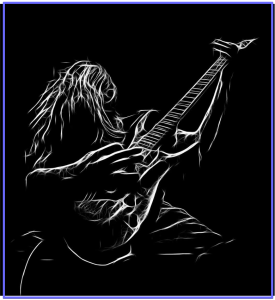 Would You Add One To Your Collection?
Would You Add One To Your Collection?
Yes
I like the neck size because I am used to working my techniques on a nylon-string classical guitar for finger strength and dexterity.
Having a 7-string in your toolbox can expand your creativity on the Guitar and help to make you a better player.
They take a bit of getting used to in sound feel and application, but once you get the hang of them, they become second nature.
Did You Like This Article?
Check out the Al Di Meola Signature PRS Prism
Also…
Please leave your comments in the section below, and if you have a favourite player or Guitar you would like me to review, leave a note below.
As always, stay the course and keep playing.
See you in a couple of weeks.
Feature image courtesy of Pete Linforth from Pixabay
Fender Telecaster Image Courtesy of Nina Garman from Pixabay
Image of Guitar player Art Courtesy of Ivan Ivankovic from Pixabay

Starting A Journey At 7 Years Of Age, The Love For The Guitar Only Became Stronger Going Into My Teens. This Leading To An Exciting Time Of Teaching, Performing, And Recording. Join Me Now As We Can Bring The Love Of This Instrument To Other Musicians Globally.




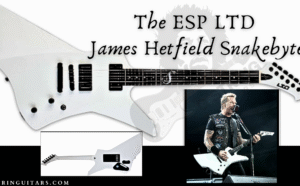
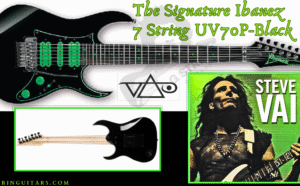

I really like the pieces of history you’re providing, the good old frying pan haha! I never owned a 7 string but I think I could benefit from it, how much time did it take you to get used to it? Would you say it’s almost exclusively reserved to shredders?
Thanks for providing valuable information on the matter, and I really like your site by the way!
Hello Oliver
Thanks for the visit and for leaving your thoughts.
Adding some history into the content is an excellent way to see how some of these designs evolve, so as we build out on a topic, it has a history component.
About the 7 string, getting used to it is about how comfortable you are with a 6 string.
Once you understand a standard guitar, the added string is an easy addon as an option in your expression.
The guitar has made its mark in the Metal world but not for shredders as much as Nu Metal.
But the instrument started as a Jazz guitar, so it is flexible enough to play in other Genres.
My Music is not mainstream as well; it’s a Euro Pop Opera niche, and it works well, for chords are fuller and more bottom ended.
But at the end of the day, it’s more of a personal preference, for you should also have a standard 6-string.
I think that’s why Steve Vai made his 7 String JEM identical to his 6 String JEM, leading to the PIA.
Again thank you for your feedback and the positive comments on the site.
Do not hesitate to come back and read more.
Cheers
Dino@Gstringuitars
Cool and informative article on the comparison between 6-string and 7-string guitars! It’s fascinating to learn about the origins of the 6-string electric guitar and how it revolutionized music, turning the guitar into a lead instrument. The introduction of the 7-string guitar brought new sonic possibilities and contributed to the development of genres like nu metal. It’s great to see the advantages and disadvantages of both types of guitars laid out, allowing readers to make an informed decision based on their playing style and preferences. Are there other genres (or well-known artists) that are known for 7-strings, or is it mostly metal bands?
Hello Aly
Nice to meet you, and thank you for coming by the site and leaving your thoughts.
To answer your question, the 7 string has been highlighted in the metal genre, but will always be used as an instrument for other players as well, along with the 8-string in many other genres less mainstream.
Do not hesitate to read some of other posts and leave your thoughts, like on The Enya Nova Go Guitar SP1 Acoustic Electric.
Cheers
Nice article covering all of the basses. Even though you mention seven stringers were also used some for jazz, perhaps most modern players thing of it as a way to get heavier. It is also a way to be more orchestral and sophisticated as a solo guitarist. I have a hollow body Schecter Jazz 7 and a solid body Ibanez seven string and you can play a great walking bass line under chords making for fantastic accompaniment for a vocalist ever as a rhythm guitarist bass player at the same time under s lead guitar or other solo instrument like a horn, flute or violin. It is sort of like having a portable piano.
Hello Howard
Thank you for coming by and leaving your comments.
I agree with you its not only for the heavy players its still quite a versatile instrument for other styles such as Jazz players that like to work with different chord voicings and basslines and counterpoints.
Please do not hesitate to come by and leave your thoughts on some of our other posts.
Kindest regards
Dino@gstringuitars